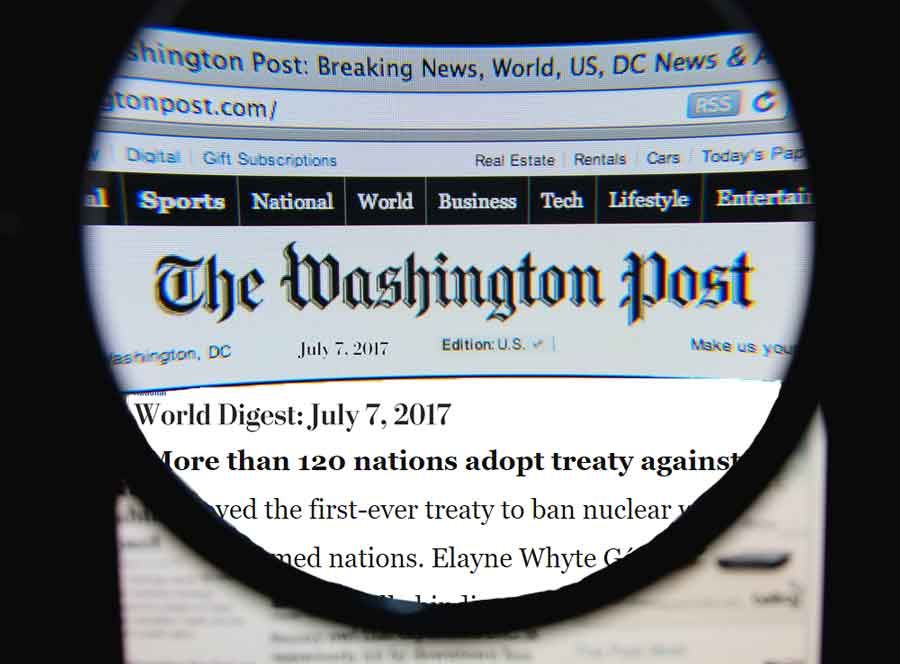The nuclear weapons ban treaty (not) in the news?
By Hugh Gusterson | July 14, 2017

Readers of the Washington Post who looked in the Saturday, July 8 print edition for international news would have found the following stories: On the front page there were two articles about Trump’s performance the previous day at the G20 summit in Hamburg, plus a long story about state regulation of marijuana in Uruguay. On page four there was a story about violent protests against the G20 summit and another about an agreement between the United States and Russia for a partial ceasefire in Syria. Finally, on page nine, there was one article about the imminent defeat of ISIS in Iraq and another about Israel’s cancellation of a Dutch solar power project in a Palestinian village.
That was apparently all the international news worth noting. Except perhaps for this one-paragraph story, the last in the “News Digest,” buried at the bottom right corner of page nine: “More than 120 countries approved the first-ever treaty to ban nuclear weapons Friday at a UN meeting boycotted by all nuclear-armed nations. Elayne Whyte Gomez, president of the UN conference that has been negotiating the legally binding treaty, announced the results of the ‘historic’ vote: 122 nations in favor, the Netherlands opposed and Singapore abstaining.”
Really? Is that all Washington Post readers need to know about an agreement between nearly two thirds of the countries on the planet to ban weapons that could destroy the human race? Just two sentences? The extensive coverage of the G20 summit is understandable (even if the summit was largely portrayed as a showdown between Trump and Putin rather than a meeting between the twenty leading heads of state in the world). But how is it that an agreement by a clear majority of the world’s governments to ban nuclear weapons gets two sentences, while the plight of solar power in one Palestinian village gets over half a page and Uruguayan regulation of marijuana gets extensive front-page exposure? Might not Washington Post readers want to know a few more details about the nuclear weapons ban—for example, why the nuclear powers boycotted the meeting (and who those powers are); which countries pushed the treaty forward; and how the signatories of this “legally binding treaty” envisage enforcing it upon all those nuclear weapons states that spurned the negotiations.
We hear a great deal today about the damage done by “fake news.” But, as media coverage of the nuclear weapons ban treaty shows, the fake news directed at an unsophisticated public may be less insidiously corrosive than some of the high-end news consumed by the nation’s elites. Public opinion is more powerfully, and more discreetly, shaped and distorted by news coverage that, instead of flagrantly making things up, marginalizes certain stories or frames them in ways that neutralize and undercut them.
If the Washington Post undercut the nuclear weapons ban story by shrinking it to postage stamp scale and hiding it next to a colorful “never clean your gutters again” ad five times its size, the New York Times gave it the column inches it deserved, but undercut it through turns of phrase and omissions that skew the story’s import, making it harder for American readers to understand the political context that produced the treaty.
The New York Times story renders almost invisible the 122 countries, mostly from the global south, that signed the treaty. This starts with the picture accompanying the story. It is of the British and American ambassadors, who both condemned the treaty. (By contrast, the photo accompanying the British Guardian newspaper story on the treaty features a jubilant ambassador from Costa Rica celebrating the vote). The New York Times quotes British, French, and American statements condemning the treaty. It does not identify any of the countries that signed the treaty, nor does it quote their diplomats with the single exception of Elayne Whyte Gomez, the Costa Rican ambassador to the United Nations who chaired the negotiations. On the other hand, it features extensive quotes from Beatrice Fihn, the European executive director of the International Campaign to Abolish Nuclear Weapons, as well as from Daryl Kimball, executive director of the Arms Control Association. You would think the treaty was negotiated entirely by non-governmental organizations. One hundred and twenty-two largely non-Western countries negotiated and signed the treaty, but almost all the talking in the New York Times is done by Americans and Europeans. If we want to know what those black and brown diplomats were thinking, we will have to look somewhere other than the New York Times.
Many of those diplomats are upset that, in their view, the nuclear powers, which are all busy “modernizing” their nuclear stockpiles, are not complying with their obligations under Article VI of the 1970 Nuclear Non-Proliferation Treaty. That Treaty represented a bargain between the nuclear and non-nuclear nations in which the latter agreed not to acquire nuclear weapons if the former promised a process by which they would give the weapons up. Article VI states that “each of the parties to the treaty undertakes to pursue negotiations in good faith on effective measures relating to cessation of the nuclear arms race at an early date and to nuclear disarmament.” The New York Times article gestures vaguely at this grievance by saying that “the new agreement is partly rooted in the disappointment among non-nuclear-armed nations that the Non-Proliferation Treaty’s disarmament aspirations have not worked.” But this wording is deeply misleading: It misrepresents binding legal obligations as “aspirations” and implies that they failed all by themselves, rather than having been blocked by powerful countries unwilling to give up the ultimate weapon. And “disappointment” is surely an inappropriately mild word to describe the feelings of leaders who fear that their people will be killed by the fallout from other countries’ nuclear war. The article also misrepresents the treaty’s commitment to achieve nuclear disarmament as a commitment to merely advance it, saying that “Under the 1968 Nuclear Non-Proliferation Treaty, signed by nearly all nations, parties are required to ‘pursue negotiations in good faith’ aimed at advancing nuclear disarmament.”
In an analysis of the language patterns of nuclear weapons professionals, Carol Cohn observed that the weapons themselves and abstract nouns such as “deterrence” and “balance of forces” often seem to have more agency than people. The New York Times article reproduces this deterministic worldview when it says that “aspirations have not worked” and that “[n]uclear weapons have defied attempts to contain their spread since the United States dropped two atomic bombs on Japan in 1945, ending World War II.” In this sentence it is the weapons, not people, who are in the driver’s seat.
The wording and its effects are subtle, but the subtext of the article is that the persistence of nuclear weapons is inevitable, that human beings have little say in the matter, and that all those countries behind this treaty—making up two thirds of the membership of the UN—don’t matter. In fact, they matter so little that they are not worth naming. This is precisely the worldview that incited transnational support for the weapons ban treaty. The New York Times seems determined to demonstrate that Americans don’t get that.
We rely on the New York Times to inform our elites. Surely the newspaper of record of the leading global power could do a better job of explaining to its readers why nearly two thirds of the countries in the world are disillusioned with the established framework for nuclear arms control, and how the United States and its NATO allies lost control of the United Nations in the face of an antinuclear rebellion.
Together, we make the world safer.
The Bulletin elevates expert voices above the noise. But as an independent nonprofit organization, our operations depend on the support of readers like you. Help us continue to deliver quality journalism that holds leaders accountable. Your support of our work at any level is important. In return, we promise our coverage will be understandable, influential, vigilant, solution-oriented, and fair-minded. Together we can make a difference.
Keywords: TPNW, Treaty on the Prohibition of Nuclear Weapons, nuclear ban treaty
Topics: Columnists, Nuclear Weapons














